Strawberries
Day of Science and Service for UCCE Centennial
To my readers:
Tomorrow is the 100th birthday of UC Cooperative Extension in California. It's been an honor for me to take part in 12 of those 100 years and what a long, interesting and productive journey this has been so far!
You are all invited to our open house tomorrow at the UCCE Santa Cruz County office in Watsonville on 1432 Freedom Blvd from 3 to 6 pm.
Also, even if you can't make it out to our open house, try and participate in our Day of Science and Service. There are three different exercises in the link below, but try out the pollinator counting. This is a pretty neat exercise, where each of you counts pollinators - don't forget, bees aren't the only ones pollinating- for three minutes.
Try it out - and remember to wish UCCE Happy 100th Birthday tomorrow!
http://100.ucanr.edu/Day_of_Science_and_Service/
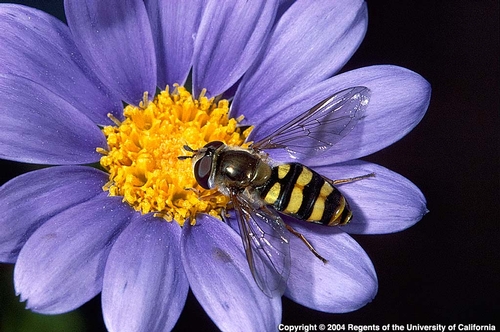
Syrphid fly on flower - yes these are also pollinators! Count them tomorrow for three minutes as part of UCCE's Day of Science and Service.
Intrepid 2F Now Labeled for Use in Caneberries
Intrepid 2F is now labeled for use on lepidopterous pests in caneberries. It's a very good material, we managed to take some of the tailwinds generated by the LBAM storm to get this one through quicker. It's good to have a local Farm Advisor around for these types of things isn't it?
Caneberry label attached below.
Intrepid caneberry
Unusual Flare-up of Leaf Blotch Disease of Strawberry
Leaf blotch disease, caused by Zythia fragariae, is a very minor foliar disease of strawberry in California. Usually the disease occurs in late winter/early spring when there are sufficient rains to activate the fungus and spread the spores. Once the winter season rains have ceased, the disease subsides before the development of much fruit. Because of the drought, leaf blotch was generally not observed or reported during the late winter/early spring of this season.
However, an unusual flare-up of leaf blotch is currently developing in some fields in the central coast. Because of the lack of rainfall and build up of salts in the soil, some growers used sprinklers in the early spring to alleviate salt buildup and reduce subsequent stress of the strawberry transplants. It appears that in some cases, the sprinkler irrigations have enabled Zythia to develop and cause typical leaf blotches. Symptoms consist of tan to gray leaf lesions that commonly (though not exclusively) develop along the margin or edge of the leaflets (Photo 1). Leaf blotches are irregular in shape and may be surrounded by a purple border. These affected areas tend to grow fairly large; they can expand and cover from 1/4 to 1/2 of the leaflet surface. A key diagnostic feature of leaf blotch is the presence of tiny, brown to black, fungal fruiting bodies in the gray blotches (Photos 2 and 3). These fruiting bodies produce tiny spores (Photo 4) that are readily spread by splashing water.
A related development is the formation of brown to tan lesions on the calyx tissue of strawberry fruit (Photo 5). Calyx lesions appear to be associated with plants having the leaf symptoms. In some cases, the Zythia fruiting bodies are present in the calyx lesions and appear as darker brown, circular to oblong structures (Photo 6). However, fruiting bodies are not always present; since there are other physiological or environmental factors that can result in damage to fruit calices, care should be taken when diagnosing this problem.
UC Cooperative Extension does not have efficacy data for fungicide use for leaf blotch; therefore, we do not recommend or suggest the use of fungicides. Researchers in other areas (Europe) have determined that the following materials have good effectiveness against the leaf blotch pathogen: Pristine, Quadris, Rally. Switch also reduced disease but was less effective. This April occurrence of leaf blotch following sprinkler irrigations is a good reminder of how environmental conditions are essential for the development of plant diseases. This leaf blotch situation may continue to be present if any late April rains fall.
There are fungicides mentioned for management of leaf blotch disease in this article. As always, before using any of these products, check with your local Agricultural Commissioner's Office and consult product labels for current status of product registration, restrictions, and use information.
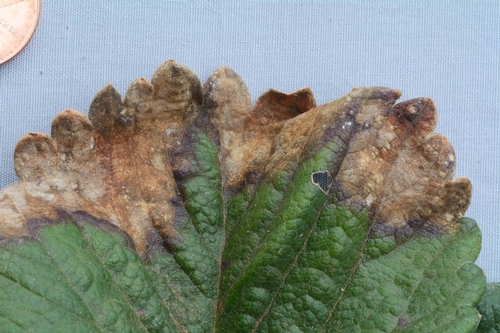
Photo 1. Leaf blotch is characterized by irregularly shaped, gray to brown leaf lesions. Photo: Steven Koike, UCCE.
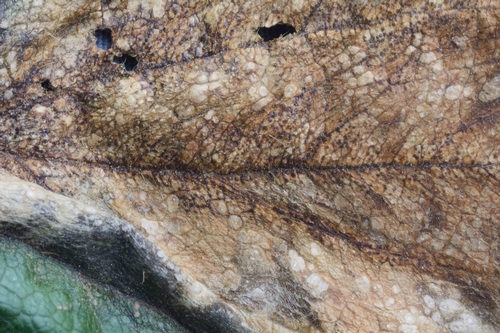
Photo 2. Fungal fruiting bodies are usually present in the leaf blotch lesions. Photo: Steven Koike, UCCE.
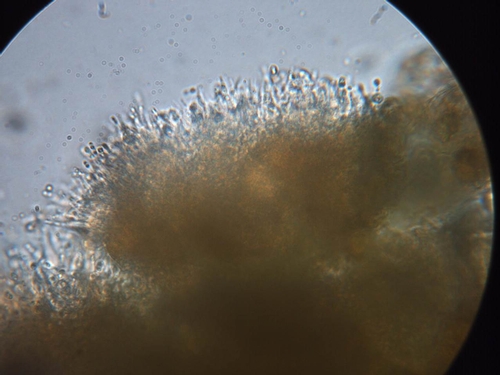
Photo 3. Close up photograph of a portion of the Zythia fruiting body; each upright spike produces an infective spore. Photo: Steven Koike, UCCE.
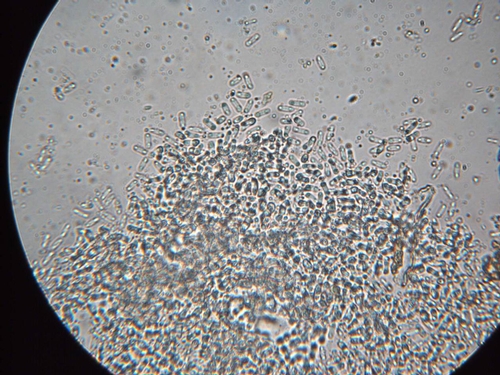
Photo 4. Zythia produces tiny spores that are spread by splashing water. Photo: Steven Koike, UCCE.
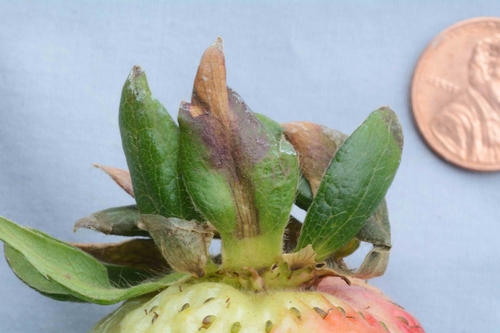
Photo 5. In some cases, it appears that Zythia is causing lesions on fruit calyx tissue. Photo: Steven Koike, UCCE.
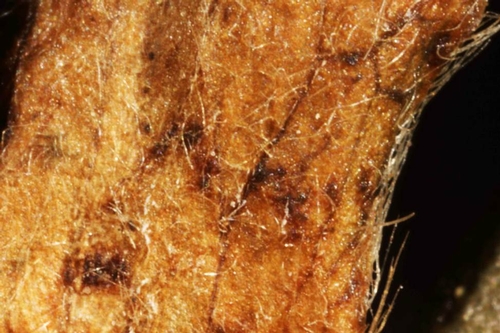
Photo 6. Fruiting bodies in strawberry calyx tissues confirm the presence of Zythia. Photo: Steven Koike, UCCE.
Pseudomonas Blight Discovered on Raspberry in Watsonville.
In the winter (February) of 2013, a field of raspberries in Watsonville was discovered to be infected with Pseudomonas syringae, the causal agent of Pseudomonas blight disease. This was the first documentation of this disease on raspberry in our region.
As pictured below, the infection of raspberry plants is manifested by brown, angular-shaped, water-soaked spots on the developing leaves, petioles and emerging plants. The grower reported a sort of “sweating” of the infected plants early in the morning, which could be due to leakage from tissues broken by bacterial activities. Many of the smaller, emerging plants had died back, but thanks to the carbohydrate reserves in the crowns and roots, they grew back and recovered once the weather warmed up. Outside of the great delay in growth, the field bore fruit normally.
As is the case for most bacterial problems, once the weather becomes warm and dry, this bacterium becomes less active in raspberry and disease normally subsides. This field indeed improved with the warming and drying weather over subsequent weeks. However, it would be interesting to see if the disease again would develop in the fall with the return of cooler and wetter conditions and the presence of wounds created in the foliage from insects, wind, or cultural practices. Pseudomonas syringae survives the winter in the plant buds and also lives as an epiphyte (growing on the surface of the plant but not invading it).
Chemical control should be used with caution, since many of the chemicals recommended for treatment could also damage the plants, especially the delicate, early season foliage. However, if this disease is a significant problem, it is strongly recommended that the grower apply either a fixed copper or Bordeaux mixture to canes after harvest but before the fall rains. Such applications can reduce the bacterial inoculum on the canes and buds. We will be monitoring caneberry plantings for Pseudomonas blight so as to determine whether this will be an on-going disease concern for the industry.
As of the date of this blog (spring 2014), Pseudomonas blight has not yet been observed and reported for this current season on caneberry in our coastal region. If you see suspect symptoms, submit samples to our Cooperative Extension office for laboratory testing and confirmation.
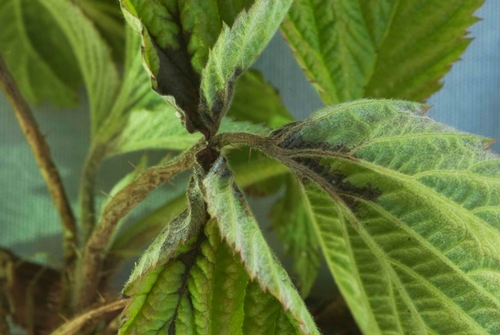
Initial symptoms consist of a dark, water-soaked, or greasy looking infection on leaves.
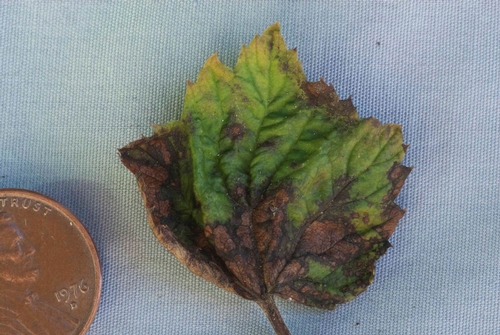
In advanced stages, diseased leaves have irregularly shaped, brown to dark brown lesions.
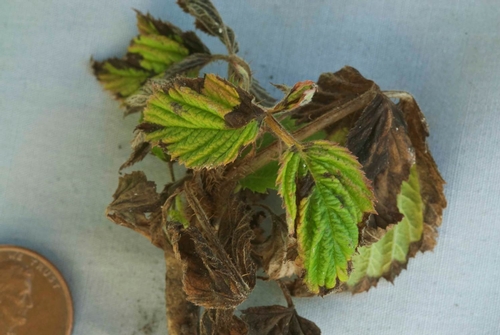
Raspberry shoots infected with this pathogen exhibit a blight-like symptom.
Zinc Nutrition of Soils and Crops in the Salinas Valley
Excellent article posted on the Salinas Valley blog by colleagues Richard Smith and Tim Hartz on zinc nutrition of crops and soils in the Salinas Valley.
Key takeaways:
1- Historically zinc deficiency was common in California, but now because of widespread use of zinc fertilizers, zinc deficiency is pretty rare. I concur, and as a matter of fact have yet to find a single plant sample which was deficient for zinc.
2- Bioavailability of zinc is limited by increasing soil pH, high clay content, high phosphorous and low soil temperature.
3- Tissue zinc sufficiency is between 15- 30 ppm (anecdotal note- blackberries tend to be in the range of 40 ppm)
4- Most common soil zinc test is DTPA extraction, which gives a good estimate of what is plant available. Generally, soil DTPA extracts from 0.5 ppm - 1.5 ppm means crop plants in that soil would probably respond to the addition of a zinc fertilizer, while a test above 1.5 ppm means there likely will be no plant response to zinc addition.
You really should read the whole article, it's quite good and definitely worth the while:
//ucanr.edu/blogs/blogcore/postdetail.cfm?postnum=13163

Zinc

